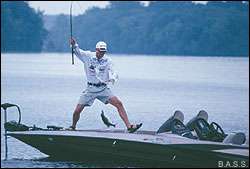
BIRMINGHAM, Ala. — Everyone expected Aaron Martens to do what he does best, which is why he was an early favorite for a Classic win at Lay Lake.
All the ingredients were there: current, ledges and big spotted bass. And with his expertise at finding and catching bass with a drop shot rig, the stars appeared to align for the 29-year-old California pro.
Martens did excel at Lay Lake, but not with the popular West Coast finesse technique many thought he would employ. Instead, Martens brought another unusual technique down to Dixie and finished second overall with 39 pounds, 9 ounces.
"It used to be a secret, but I guess it's out now," said Martens, who used hair jigs to catch schooling spotted bass, a decision that delivered $55,000 in cash and merchandise for a week's worth of work.
Martens used the hair jig to groom three consecutive limits from the rocky shoals below Logan Martin Dam.
"In California the hair jig is a dependable lure when all else fails," said Martens. "I originally figured that out a long time ago when I was a kid fishing for stripers. So when I started bass fishing, I just kept using hair jigs."
Ironically, the only two things standing in the way of Martens and a Classic championship were Jay Yelas and a shortage of the clandestine jigs. After committing to the game plan during the official scouting period, Martens spent the weeks prior to the Classic on a scavenger hunt to replace all the lures he lost while casting into the rocks.
I'd keep my eyes open and look for boils in the current to identify the shoals.
His inventory was replenished with a hodgepodge collection from Bass Pro Shops, Cabela's and several other independent retailers.
And then there was Yelas, who Martens said could have stayed ashore on Saturday after taking a commanding lead in the second round. Yelas was indeed untouchable, but it was his floating fan gallery that slowed progress for Martens.
"It's not their fault at all, but the spectator boats really muddied up the entire river," he said. "It was just incredible. We were both up there. Jay mostly fished the shoreline, and I targeted schooling fish out in the middle. The water was already shallow up there, and when the boats came by, it changed the entire river within 10 minutes."
After recognizing boat traffic would keep the open-water fish in a state of confusion, Martens abandoned a previous plan to fish for schooling spots with topwaters. Out came the hair jigs, ranging in size from 3/8- to 1/2-ounce models and each dressed with either solid white or white/chartreuse skirts. The lighter model was fished when the fish were feeding aggressively, and would remain higher in the water column for longer periods of time. The heavier jig was used in stronger current and when the bass were positioned along the bottom of the lake.
Martens jigged his daily catch with a 6-foot-8 MegaBass Diablo graphite/glass-tip rod (medium action). His Daiwa baitcasting reel was spooled with 20-pound-test Machinegun Cast Sunline, a Japanese product planned for importation to the United States in the very near future.
"The fish were coming up real fast," explained Martens, who entered the tournament as the points leader from the B.A.S.S. Western Division. "They would come up in groups of two or three fish, get the bait and go back down. The topwater was out because they wouldn't stay up for long. And a crankbait wouldn't work because it would go beneath them. So what I was doing was throwing just past the boil, letting the bait sink, and then hop it through the rocks real fast."
Martens said the spotted bass in that area of Lay Lake were feeding on shad from behind the rocky shoals facing the current-swept channel. The shoals came up to within 4 or 5 feet of the surface and were surrounded by 10- to 12-foot depths. With the dam generating current, Martens positioned his boat parallel and downstream of the targets and would cast the jig upstream, hopping it back to the boat.
"I'd keep my eyes open and look for the boils in the current to identify the shoals. When I found one, I'd go there and start casting."
Prior to competition, Martens predicted that he could catch at least 14 pounds each day with the hair jig. He came close to that prediction.
He caught 14 pounds, 1 ounce on the first day, 11-2 the next day, and finished with another 14-1 limit.
In the end, Martens lived and died with the current.
The current was reliable on the first two days, coming up by 10 a.m., with the action beginning one hour later. Saturday was a potential disaster, with the dam operators sleeping in.
With the jig bite as sluggish as the current on the final day, Martens relied on yet another unconventional technique, one seldom considered by Alabama bass fishermen.
That West Coast technique involved a 4-inch Zoom Finesse Worm (watermelon) rigged to a 2/0 Gamakatsu Extra-Wide Gap hook tied to 10-pound-test Sunline and fished on Daiwa/MegaBass spinning gear. The key to the rig was a 1/32-ounce split shot pinched above the hook.
The ultralight rig was cast into the trees and laydowns along the shoreline and allowed to drift into the cover. Martens struggled, but filled out his limit with the worm in the muddied water.
With his supply of hair jigs nearly expended, replenishing the stash would have been impossible. Classic rules allow contenders to obtain lures only from another contestant. And hair jigs were a rarity in the tackleboxes of 52 contestants, except for one.
And in the end, that proved a good thing for Martens.

